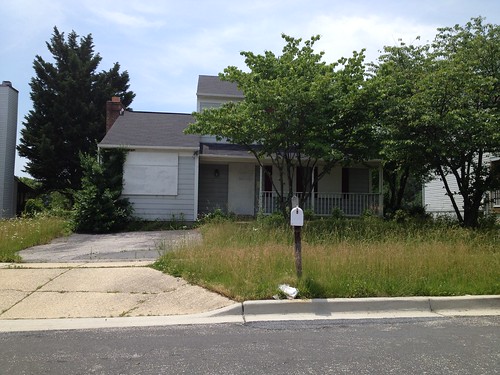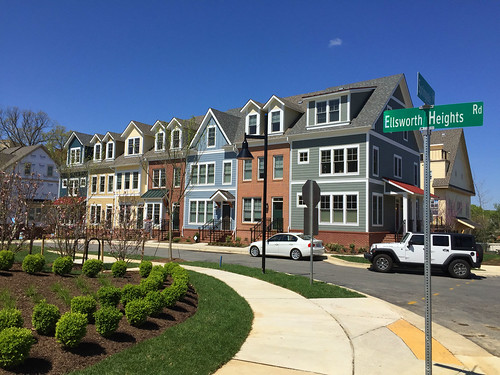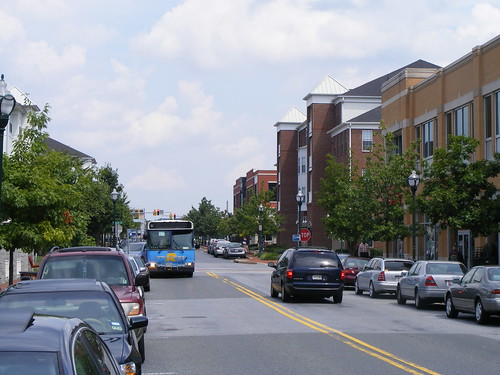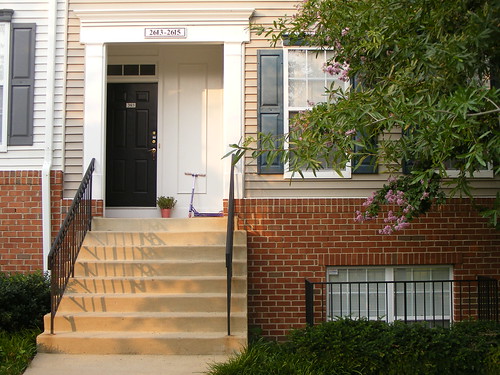Nearly a decade ago, the Great Recession wiped out house values across the region. Today, booming close-in, urban areas have basically recovered. But many further-out, suburban communities are still struggling. Here’s one example from eastern Montgomery County.
 |
| A 2000s-era subdivision in East County. Many of these homes lost value during the Great Recession and have yet to recover. All images by the author. |
I grew up in downtown Silver Spring at a time when people were still moving away from urban centers. Twenty years ago, my neighborhood
consisted of abandoned buildings and boarded-up stores, and in 1998, my parents started looking for houses outside the Beltway in places like Olney and Burtonsville, which seemed ascendant at the time. Besides, we were already driving to shop there. My parents found a little split-level house a mile from a new shopping center with a Target, Chipotle, and Starbucks.
My high school, Blake, opened that same year, and most of my friends’ parents seemed to have made the same move from Silver Spring and Takoma Park. New subdivisions were popping up with big, luxurious houses, lush lawns, and names like Briarcliff Manor and Hampshire Greens. In the older neighborhoods,
houses were sold for the land so big McMansions could rise in their places.
I remember going to a party at the end of high school where we sat in a circle bragging about how much our parents’ houses were worth. I was the odd one out because my parents’ house had appraised recently at a measly $500,000.
 |
| An abandoned house in an East County subdivision in 2014. |
But it wouldn’t last; the Great Recession hit East County pretty hard. Burtonsville Crossing, the shopping center where we hung out in high school,
is almost completely vacant. Some of my parents’ neighbors, unable to make ends meet, resorted to
running illegal auto shops out of their homes,
inviting relatives to move in, or renting out their basements.
Meanwhile, downtown Silver Spring had a comeback as more people sought urban living. A major redevelopment project along Ellsworth Drive brought restaurants, shops, movie theaters, and a Whole Foods. Montgomery County poured millions into new public facilities, including a library, the Civic Building, and Veterans Plaza. In response, private developers built thousands of new apartments and condominiums, including the building I live in now, a converted bottling plant that was still operating when I was a kid.
Here's how the real estate market in East County has changed
The real estate market shows how Silver Spring has bounced back from the recession while East County has struggled. Here’s a graph showing average home values in 2012 and 2017 as they compare to 2007 levels. It shows the two zip codes inside the Beltway, 20910 (Silver Spring) and 20912 (Takoma Park), and seven zip codes (mostly) outside the Beltway: 20901 (Four Corners), 20902 (Wheaton), 20903 (Hillandale) 20904 (Colesville, Fairland), 20905 (Cloverly), 20906 (Aspen Hill) and 20866 (Burtonsville).
 |
| How 2012 and 2017 home values in East County stack up to 2007 levels. Click on all of these graphs to enlarge them. |
Home values all over East County fell during the Great Recession. In zip codes 20903 and 20906, home values fell by nearly half between 2007 and 2012. This year, average home values in the eight zip codes outside downtown Silver Spring are 71% to 85% of what they were a decade ago. But in zip code 20910, which contains downtown Silver Spring, values are actually a little higher than they were 10 years ago.
 |
| Home values inside the Beltway have recovered, but remain lower elsewhere. |
Homes inside the Beltway have been more valuable than those outside it for a while now. But the gap in home values has increased over the past 10 years. This graph shows the average home sale price per square foot, as a way to even out differences between houses of different sizes and styles. In the summer of 2007, the price per square foot in zip codes 20910 (Silver Spring) and 20866 (Burtonsville) were fairly close, at $363 per square foot and $304, respectively. Today, they’re $384 and $257; in other words, a difference of 50%.
Those who bought homes in East County before the housing boom, or at the bottom of the market, may have recovered their investments or even made a little extra. But those who bought at the top of the market saw their gains wiped away.
 |
| Homes in far-flung zip code 20905 linger on the market longer than homes closer in. |
Another measure of demand is the number of days a house sits on the market. During the Great Recession, houses across East County languished for months due to a lack of buyers. In early 2008, the average house in zip code 20905 sat on the market for nearly six months. Demand returned, but not equally. In early 2017, homes in the 20910 zip code spent just 22 days for sale, compared to 59 days in 20905.
There's a huge opportunity in East County, but things need to change
Like many aging suburbs, East County is
caught in the middle. The kids I grew up with have either moved to urban areas closer in, or moved
farther out to newer suburbs in Olney or Howard County, aided by new highways like the
InterCounty Connector that made it easier to commute longer distances. East County is a long drive from Montgomery County’s biggest job and shopping centers, which are all along Rockville Pike and I-270. And the
local schools struggle with a negative reputation compared to their counterparts in more affluent areas.
 |
| New townhomes in downtown Silver Spring, where home values are higher than they were in 2007. |
Yet the fact that homes here are much more affordable than in other parts of the county could be a big opportunity. Nationwide, some three million Millennial homebuyers have been
shut out of the housing market because of high prices and a
lack of supply. Millennials are open to living in suburban areas, but
want stuff they can walk or bike to.
Providing that lifestyle in East County is imperative to drawing people and investment to this area, just as it did in Silver Spring. Montgomery County’s plans to create a
walkable town center and research park in White Oak and
a new village center in Burtonsville will bring the
amenities people want, while a
new BRT line on Route 29 will provide faster, more reliable transit. Combined, the two will give East County access to jobs, shopping, and economic opportunities.
East County has waited decades for the kind of prosperity the rest of Montgomery County takes for granted, and at great cost. Hopefully residents won’t have to wait much longer.
























